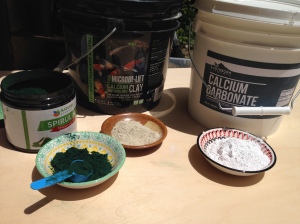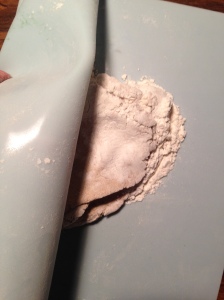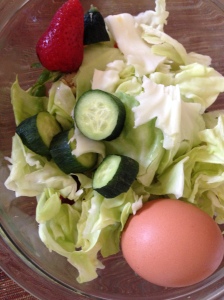Tags
calcium, fish tank, food, how to, mineral blocks, shell erosion, snails

DIY Mineral Blocks for Aquarium Invertebrates
Here’s a quick walk through on how to make mineral blocks for invertebrates such as snails and shrimp. It’s fast and easy to do and your snails, shrimp, crayfish and/or crabs will thank you! The goal is to provide calcium and other vital minerals to your bottom feeding tank crew in an instantly sinking form so they can get to munching right away.
Here’s the recipe:
Step 1
Gather the ingredients:
Calcium Carbonate [high purity grade] — 3 tablespoons
Bentonite [aka Montmorillonite Clay] — 3 tablespoons
Unbleached Wheat Flour — 1/4 cup
Distilled, bottled or conditioned tap water — 1/2 cup
Step 2
Mix all the powder components in a bowl until the mixture looks even.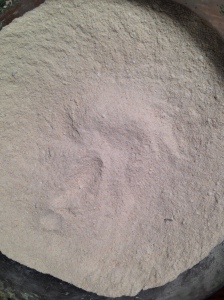
Step 3

Add water and mix well. You might not need to use all the water, just a little at a time until a soft dough forms. It shouldn’t be soupy, just moist enough, kind of like pasta dough. You can always add a bit more flour if the mix is too wet. Knead well.
You can also add protein like this medley of crickets, river prawn and mealworms.
Grind the medley in a coffee grinder to a fine powder. Careful! If not finely ground, you may encounter a few very sharp small bits in the dough such as cricket legs and shrimp jaws [ouch]. Wear gloves or knead with a silicone sheet to protect your hands.
Water can be distilled but I like to use this combo which I use for conditioning tank water anyways:
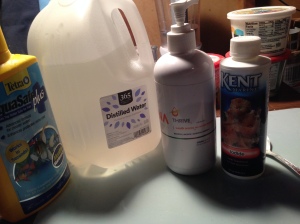
From left to right: Tetra purifier to get rid of chlorine, regular tap water, shrimp safe copper free fertilizer to supply Magnesium, Iron, Molybdenum, etc., and a drop of Iodide. Iodide is strong stuff–the recommended dose of Kent’s Iodide is 2.5 ml (1/2 teaspoon) per 25 gallons of tank water dosed once a month. I prepare the water for my tanks in bulk using 5 gallon pails.
Step 4
There are many ways to process the dough into smaller pieces.
My favorite is running it through a pasta machine like this one: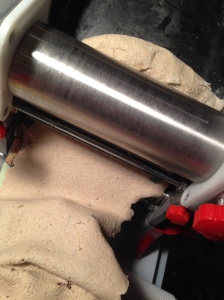
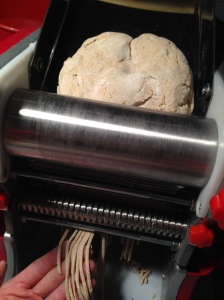
Other ways: rolling the dough out in sheets and cutting it with a rolling pasta cutter or a fondant cutter, or pressing the dough into molds, running the dough through a meat grinder to make “noodles”.

The goal is to make smaller units from this dough which will be convenient to feed later on and they will also dry more quickly and evenly for storage without the risk of spoiling. Big chunks of dough tend to spoil before they dry out thoroughly.
The above batch makes a lot of mineral blocks which will last your tank crew a while!
Step 5
Optional –
You can dry the pellets in a dehydrator (about 3-4 hours) or just leave them out to air dry.
Storage:
I recommend cardboard boxes (such as from noodles or tea boxes) for storing the pellets.
Step 6
Present the food to the panel of experts: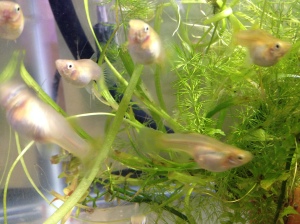
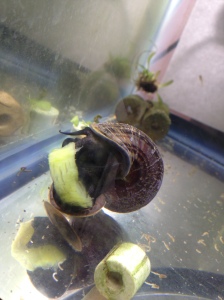
Dough with added Spirulina or Chlorella will be green:
Other stuff you can add: fresh veggies and fruit (grind them up in a food processor first):
Cucumbers, sweet peas, strawberries, zucchini, fresh whole eggs, cabbage, spinach, beets, garlic, lettuce, cauliflower, moringa leaves, dandelions, soybeans, honey, bananas, duckweed… the list goes on!
Some different types of food shapes:
Things to avoid — in general, fish and other tankmates don’t like the following foods:
- anything tart like oranges and apples
- meats like beef and pork can’t be easily digested by them. Fish and shrimp meat can be added instead to supply protein
A note about minerals…
Invertebrates need certain minerals to build up their shells and exoskeletons. Otherwise they’ll experience serious problems which will shorten their life span. For example, calcium deficiency causes white streaks on snail shells and shell erosion, pitting and pinholes. Once the external shell has been compromised, the snail’s internal organs are left vulnerable to parasitic and bacterial infections. Shrimp, crabs and crayfish also need minerals including calcium to successfully molt and build new exoskeletons.
Cuttlebones can also be used as a calcium source, but they look ghastly in a fish tank, and take forever to sink. You can boil them to sink them right away, but either way, they will either float on the surface scaring the fish or sit on the bottom collecting gunk. After a while they start to smell and turn yellowish from all the absorbed stuff.
Next post will be about the Marbled Crayfish!

